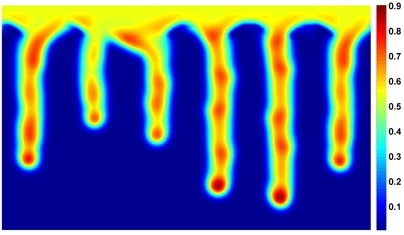MIT researchers have found an elegant solution to a sticky scientific problem in basic fluid mechanics: Why water doesn't soak into soil at an even rate, but instead forms what looks like fingers of fluid flowing downward.
Scientists call these rivulets "gravity fingers," and the explanation for their formation has to do with the surface tension where the water -- or any liquid -- meets the soil (or other medium). Knowing how to account for this phenomenon mathematically will have wide-ranging impact on science problems and engineering applications, including the recovery of oil from reservoirs and the sequestration of carbon underground.
The solution, reported in the Dec. 12 issue of Physical Review Letters, involves borrowing a mathematical phrase from the mathematical description of a similar problem -- a solution both simple and elegant that had escaped the notice of many researchers in earlier attempts to describe the phenomenon.
Co-authors Luis Cueto-Felgueroso and Ruben Juanes of the MIT Department of Civil and Environmental Engineering discovered the solution while studying the larger question of how water displaces oil in underground reservoirs (petroleum engineers commonly flush oil reservoirs with water to enhance oil recovery).
"Our paper addresses a long-standing issue in soil physics," said Cueto-Felgueroso. "Lab experiments of water infiltration into homogeneous, dry soil, repeatedly show the presence of preferential flow in the form of fingers. Yet, after several decades, the scientific community has been unable to capture this phenomenon using mathematical models."
"This was the type of problem that required someone from a different research discipline to take a look at it and come up with the solution," said Juanes, the ARCO Assistant Professor in Energy Studies. "Luis applied his expertise to a fluid mechanics problem in another medium -- porous media flows -- and quickly figured out the solution."
Cueto-Felgueroso, a postdoctoral associate who has previously worked primarily on airflow fluid mechanics problems, had a Eureka! moment when he realized that gravity fingers in soil (or clay or sand) look very similar to water flowing down a window pane, a fairly well-understood phenomenon. He and Juanes then pulled the mathematical explanation (think of it as a phrase of words or music) from the equation describing water on a window, and included that mathematical phrase in the equation describing liquid moving downward through soil.
After rigorous comparison of data produced by the new mathematical model with observed phenomena, the two realized they'd found the solution, a solution described by one scientist reviewing the paper in Physical Review Letters as "simple and elegant" and a "major breakthrough" in the field.
The Cueto-Felgueroso and Juanes solution also describes one aspect of the water-flowing-down-a-windowpane phenomenon that previously was not understood by scientists, who actually refer to this as "the flow of thin films": why water builds up at the tips of the fingers. Again, the answer has to with the surface tension. Before the water can flow down the film, it must build up enough energy to overcome the tension holding it in place.
So what was missing from earlier models of water moving downward through soil that made it appear to move as a steady, horizontal front, rather than in finger-like paths -- even when the soil was homogenous in particle size and shape?
The missing mathematical phrase describes the surface tension of the entire finger of water, which may be several centimeters in width, as opposed to the tension existing at the micron-scale of pores between soil particles.
And that phrase will sound like music to the ears of physicists and engineers.
The work was supported by the Italian energy company, Eni.
A version of this article appeared in MIT Tech Talk on December 17, 2008 (download PDF).






